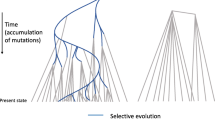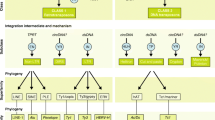Abstract
Putative nonautonomous transposable elements related to the autonomous transposons Tc1, Tc2, Tc5, andmariner were identified in theC. elegans database by computational analysis. These elements are found throughout theC. elegans genome and are defined by terminal inverted repeats with regions of sequence similarity, or identity, to the autonomous transposons. Similarity between loci containing related nonautonomous elements ends at, or near, the boundaries of the terminal inverted repeats. In most cases the terminal inverted repeats of the putative nonautonomous transposable elements are flanked by potential target-site duplications consistent with the associated autonomous elements. The nonautonomous elements identified vary considerably in size (from 100 by to 1.5 kb in length) and copy number in the available database and are localized to introns and flanking regions of a wide variety ofC. elegans genes.
Similar content being viewed by others
References
Altschul SF, Gish W, Miller W, Myers EW, Lipman DJ (1990) Basic local alignment search tool. J Mol Biol 215:403–410
Banki K, Halladay D, Perl A (1994) Cloning and expression of the human gene for transaldolase: A novel highly repetitive element constitutes an integral part of the coding sequence. J Biol Chem 269:2847–2851
Banville D, Boie Y (1989) Retroviral long terminal repeat is the promoter of the gene encoding the tumor-associated calcium-binding protein oncomodulin in the rat. J Mol Biol 207:481–490
Barker RF, Thompson DV, Talbot DR, Swanson J, Bennetzen JL (1984) Nucleotide sequence of the maize transposable elementMu. Nucleic Acids Res 12:5955–5967
Berg DE, Howe MM (1989) Mobile DNA. American Society for Microbiology, Washington, DC
Bureau TE, Wessler SR (1994) Stow-away: a new family of inverted repeat elements associated with the genes of both monocotyledonous and dicotyledonous plants. Plant Cell 6:907–916
Chang-Yeh A, Mold DE, Huang RC (1991) Identification of a novel murine IAP-promoted placenta-expressed gene. Nucleic Acids Res 19:3667–3672
Collins JJ, Anderson P (1994) The Tc5 family of transposable elements inCaenorhabditis elegans. Genetics 137:771–781
Dariavach P, Williams GT, Campbell K, Pettersson S, Neuberger MS (1991) The mouse IgH 3′-enhancer. Eur J Immunol 21:1499–1504
Federoff N (1989) Maize transposable elements. In: Berg DE, Howe MM (eds) Mobile DNA. American Society for Microbiology, Washington, DC, p 375
Federoff N, Wessler S, Shure M (1983) Isolation of the transposable maize controlling elementsAc andDs. Cell 35:235–242
Hershberger RJ, Warren CA, Walbot V (1991) Mutator activity in maize correlates with the presence and expression of theMu transposable element Mug. Proc Natl Acad Sci USA 88:10198–10202
Levitt A, Emmons SW (1989) The Tc2 transposon inCaenorhabditis elegans. Proc Natl Acad Sci USA 86:3232–3236
Luo D, Coen ES, Doyle S, Carpenter R (1991) Pigmentation mutants produced by transposon mutagenesis inAntirrhinum majus. Plant J 1:59–69
Oosumi T, Garlick B, Belknap WR (1995) Identification and characterization of putative transposable DNA elements in solanaceous plants andCaenorhabditis elegans. Proc Natl Acad Sci USA 92: 8886–8890
O'Hare K, Rubin GM (1983) Structures of P transposable elements and their sites of insertion and excision in theDrosophila melanogaster genome. Cell 34:25–35
Purugganan M, Wessler S (1992) The splicing of transposable elements and its role in imron evolution. Genetica 86:295–303
Rosenzweig B, Liao LW, Hirsh D (1983) Sequence of theC. elegans transposable element Tel. Nucleic Acids Res 11:4201–4209
Ruvolo V, Hill JE, Levitt A (1992) The Tc2 transposon ofCaenorhabditis elegans has the structure of a self-regulated element. DNA Cell Biol 11:111–122
Stavenhagen JB, Robins DM (1988) An ancient provirus has imposed androgen regulation on the adjacent mouse sex-limited protein gene. Cell 55:247–254
Streck RD MacGaffey JE Beckendorf SK (1986) The structure ofhobo transposable elements and their insertion sites. EMBO J 3615–3623
Sulston J et al. (1992) TheC. elegans genome sequencing project: a beginning. Nature 356:37–41
Sutton WD, Gerlach WL, Schwartz D, Peacock WJ (1984) Molecular analysis of Ds controlling element mutations at theAdh1 Locus of Maize. Science 223:1265–1268
Talbert LE, Patterson GI, Chandler VL (1989)Mu transposable elements are structurally diverse and distributed throughout the genusZea. J Mol Evol 29:28–39
Ting CN, Rosenberg MP, Snow CM, Samuelson LC, Meisler MH (1992) Endogenous retroviral sequences are required for tissue-specific expression of a human salivary amylase gene. Genes Dev 6:1457–1465
Wessler SR (1989) The splicing of maize transposable elements form pre-mRNA—a minireview. Gene 82:127–133
White SE, Habera LF, Wessler SR (1994) Retrotransposons in the flanking regions of normal plant genes: a role for copia-like elements in the evolution of gene structure and expression. Proc Natl Acad Sci USA 91:11792–11796
Wilson R et al. (1994) 22 Mb of contiguous nucleotide sequence from chromosome III ofC. elegans. Nature 368:32–38
Author information
Authors and Affiliations
Additional information
Correspondence to: W. Belknap
Rights and permissions
About this article
Cite this article
Oosumi, T., Garlick, B. & Belknap, W.R. Identification of putative nonautonomous transposable elements associated with several transposon families inCaenorhabditis elegans . J Mol Evol 43, 11–18 (1996). https://doi.org/10.1007/BF02352294
Received:
Accepted:
Issue Date:
DOI: https://doi.org/10.1007/BF02352294




